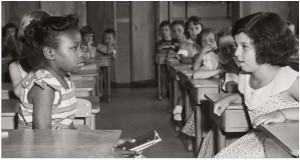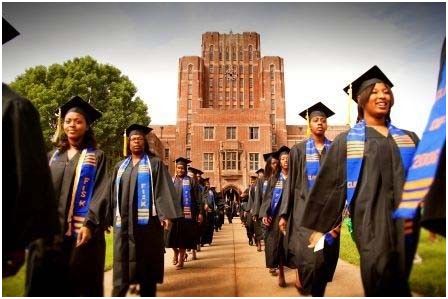The relationship between people of color and institutions of higher learning has undergone several stages since the 1950’s. White colleges and universities upheld standards and morals that created reputations of very prestigious places of higher learning. Colleges began their admissions process by simply accepting students who could financially afford to attend their institutions, sometimes regardless of their racial make-up. Although some schools had no policy against the admission of students of color, it was very rare they would attend college or that which was composed of mainly Caucasian students. Essentially banned from all-white institutions, African Americans had to resort to other methods and techniques of ensuring they would obtain an education. Historically Black Colleges and Universities became a venue for African Americans to better themselves and push for the same opportunities their White counterparts had. With the results of the Civil Rights Movement and landmark case Brown v. Board of Education, admissions policies began to change, opening up more opportunities for African Americans to attend all-white institutions.
Examining the relationship between African Americans and institutions of higher learning leads to the question: How have relations between African Americans and institutions of higher learning in America changed from the 1950’s to 2000? Was the change beneficial to African Americans? Although African Americans desired a school system that would provide an equal opportunity to equal education for all children regardless of their race, racial integration in institutions of higher learning did not prove beneficial to African Americans. This paper will focus on the transition African Americans underwent from attending mainly Historically Black Colleges and Universities to predominantly white institutions through either their own means or through access programs like QuestBridge and the Posse Foundation. In addition, it will also prove how such a shift is not beneficial to African American students.
Historically Black Colleges and Universities and the 1950’s
Because very few were able to attend all-white institutions in the 1950’s, African Americans went to Historically Black Colleges and Universities. Historically Black Colleges and Universities (“HBCU’s”) were originally created in 1837 as the Institute for Colored Youth with hopes of training African Americans to become teachers (Coleman, par. 3). Since then, the institutions have evolved into a chain of schools that are geared towards providing quality education for African American students who might not otherwise attend college due to socio-economic disadvantages, academic disadvantages, and effects of segregation policy in the United States. In the 1950’s this meant students attended HBCU’s in hopes of achieving their version of the American Dream by defeating well enforced stereotypes. Well known figures that attended and graduated from HBCU’s include Civil Rights lawyer Thurgood Marshall, Martin Luther King Jr. and Alice Walker. Virtually no African Americans have been able to attend all white institutions in the 1950’s and the few that did were able to do so because they had the financial means – something very few African Americans were able to do.

With the landmark Supreme Court case Brown v. Board of Education in 1954, the pattern of African American attendance in college institutions began to drastically change. In the case, the Supreme Court ruled that separate public schools for African American children were unconstitutional because the facilities for white and black students were substantially unequal. Although the case only applied to American public schools, colleges and universities around the nation felt the pressure to racially integrate through such cases and other efforts of the Civil Rights Movement. For instance, liberal arts institution Trinity College began its efforts to accept more African American students after student activists began requesting the school provide more opportunities for them to attend. They introduced in 1967 their Freshmen-Sophomore Honors Scholar Program to help pool more qualified students of color from disadvantaged backgrounds adjust to the academic pace (Knapp, 340).
The Issue of Scholarship
Although Brown v Board of Education created more opportunities for African Americans to have more of an equal standing with Caucasian students in education, they were at a disadvantaged level that presented obstacles for students who wished to attend college with their white counterparts. African Americans faced many restrictions through employment and housing discrimination practices that limited the level of income one could acquire as well as which neighborhood he or she could reside in. A lot of this discrimination arose even more due to the fact that African Americans began migrating to the north and other parts of the nation from the south after World War II. Their shift in location was also accompanied with a shift of upward mobility. African Americans began their attempt to break out of their current place in society where they work as maids or factory workers.
Then and even in the early 2000’s, African Americans who want to attend an institution of higher learning find it difficult to do so because of financial disabilities. It has been decades since the end of Jim Crow Segregation in both the economical and educational aspects of American society and yet African Americans suffer because of its affects. Hard work and determination were now not enough to allow students of color to attend high ranked institutions that would give them the tools to achieve their American Dream. Realizing this, predominantly white colleges and institutions began partnering with access programs to ensure that African Americans and other students of color would be able to attend their and other institutions. The prominent access program s that allowed students of color to go to top predominantly white colleges in the country began showing up starting the 1980’s. Such programs include that like The Posse Foundation , A Better Chance and QuestBridge.
Is Racial Integration in Higher Education Beneficial?
Although African Americans succeeded in gaining a place in predominantly white institutions, racial integrating in higher learning does not serve as a psychological benefit. In his piece The Color of Success, Walter R. Allen compared African American students in predominantly white institutions with those in HBCU’s and found that psychological differences. Like their white counterparts, African American students have similar or higher aspirations, but unfortunately they are unable to achieve them as much as their white classmates do; generally African American students perform lower than white students (Allen, 29). In addition to performing lower than their white counterparts, African American students in predominantly white institutions have to deal with explicit and implicit displays of racism and bigotry. For instance, African American students at Trinity College held a “Zero Tolerance” rally in response to the increased racial attacks on minorities on the campus (Trinity College). Those students, and many others on campuses around the nation, have to deal with being students at prestigious colleges, maintaining and/or raising their grade point averages, developing their own self brands and combating racism. On the other hand, African American students who attend HBCU’s tend to have more “positive self-images, strong racial pride, and high aspirations” (Allen, 29). They are also in an environment in which they can receive an excellent education, perform well academically, and develop their own self brands without the hassle of combating daily racism on the same scale as their African American counterparts in predominantly white colleges and universities.
Sources:
Allen, Walter R. “The Color of Success: African-American College Student Outcomes at Predominantly White and Historically Black Public Colleges and Universities.”Symposium: Minority Participation in Higher Education (1992). Harvard Educational Review. President and Fellows of Harvard College. Web. 1 May 2012. <http://her.hepg.org/content/wv5627665007v701/fulltext.pdf>.
Coleman, David C. “HBCU History – The History of Historically Black Colleges.” HBCU CONNECT. Connectplatform.com, 2011. Web. 03 May 2012 <http://hbcuconnect.com/history.shtml>.
Knapp, Peter J., and Anne H. Knapp. Trinity College in the Twentieth Century: A History. Hartford, CT: Trinity College, 2000. Print.
Trinity College. “Students, Faculty Rally Around the Cause of Justice, Equality and Tolerance.” Trincoll.edu. Trinity College, 28 Apr. 2011. Web. 03 May 2012. <http://www.trincoll.edu/NewsEvents/NewsArticles/pages/Students,-Faculty-Rally-Around-the-Cause-of-Justice,-Equality-and-Tolerance.aspx>.

 According to the school’s student run newspaper The Wesleyan Argus, the college’s first African American student Charles B. Ray attended the institution for seven weeks in the fall of 1832 after harsh racist acts he dealt with from white (mostly southern) students (Argus, par. 1). These students pleaded with Fisk to expel Ray; some even threatened to withdraw their attendance from the school. After Ray’s withdrawal from the school, the board of trustees at the time passed a resolution that stated “None but white male persons shall be admitted as students at this institution” (Argus, par. 1).
According to the school’s student run newspaper The Wesleyan Argus, the college’s first African American student Charles B. Ray attended the institution for seven weeks in the fall of 1832 after harsh racist acts he dealt with from white (mostly southern) students (Argus, par. 1). These students pleaded with Fisk to expel Ray; some even threatened to withdraw their attendance from the school. After Ray’s withdrawal from the school, the board of trustees at the time passed a resolution that stated “None but white male persons shall be admitted as students at this institution” (Argus, par. 1).
